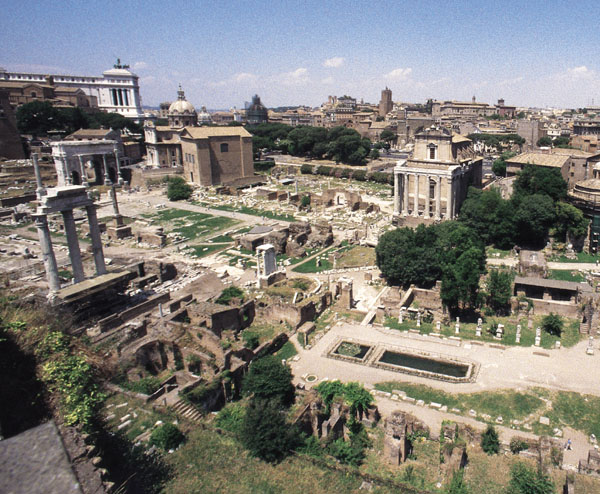

Ovid’s Ars Amatoria is a “how to” manual, in verse, for amorous young men. The poet spends some 200 lines (1.67–262) naming the best places in Rome to contrive supposedly chance encounters with women. Most of the sites are recognizable, and many are in or near the Roman Forum, but Ovid rarely names the Forum itself. For a citizen of ancient Rome, however, the Forum was the core of the city for all human activity. It was the single most obvious place to go looking for people, whether or not one had loftier business in mind than Ovid. It was as unnecessary for Ovid to mention the Forum as it is for us to specify that we are going to a theater to watch a movie—by naming the activity one implies the location. So, even though the Forum is commonly the venue for Ovid’s assignations, he uses the word itself only when he needs it to fill out a line of verse.
At its simplest the term “forum” means any open space in a city, equivalent to the Italian piazza or Spanish plaza. In this sense, “forum” could refer to a cattle or vegetable market, which in Rome were the Forum Boarium and Forum Holitorium. But the Forum was the governmental, religious, legal, commercial and social center of any Roman city. This is the site Ovid had in mind in Ars Amatoria, knowing that his readers would understand what he meant.
The institution of the forum was essentially invariable from city to city throughout the Roman Empire because every city needed a forum. The name needs no further qualification; we simply speak of the Roman Forum or the forum of Pompeii. In whatever city, the forum consisted of a large open space suitable for public activities, surrounded by the buildings needed to support them.
A modern visitor to the Roman Forum faces a challenge to make sense of the buildings and, by extension, the institutions they represented, despite the obvious majesty of the ruins. The ruins were once law courts, government buildings, shops, offices, religious sanctuaries, public amenities (such as colonnades, wells and fountains) and commemorative monuments—in short, anything that had a distinctly public function. The visitor’s challenge, therefore, is to reconstruct the hustle and bustle of myriad purposeful activities in buildings that now stand empty and ruined.
The social activities that took place in the Forum ran the gamut from taking a stroll, meeting friends and doing all manner of business to begging and courting. In cities that did not have a permanent theater or amphitheater, the forum also accommodated public blood sport entertainments, athletic events and theatrical and musical performances, as well as state-sponsored spectacles and religious rituals that have no modern counterparts. One of the few times Ovid uses the term “forum” specifically is when he recommends going there to meet women attending the public spectacles (1.163–165). Temporary bleachers were set up to accommodate the crowds, and the open space in the Forum was covered with sand to create a stage for the gladiators, beasts and performers. The Forum in Rome served all these functions until the the Theater of Pompey (c. 55 B.C.) and the Flavian Colosseum (69–96 A.D.) took over the work of putting on public performances and spectacles.
Today the buildings stand mute, but 2,000 years ago the Forum echoed with tumultuous noise and activity. One can imagine young couples, inspired by Ovid, arm in arm in the shady colonnades; businessmen arguing over nuances of contracts; shopkeepers and their customers haggling over prices; beggars and urchins of all sorts; groups of people assembled to hear speakers bellowing at the tops of their lungs about political, social, moral and philosophical issues; and priests and priestesses conducting sacrifices (anything from a pinch of incense to killing a bull). If we came on the right day, we would see gladiators killing each other to the rabid cheers of huge crowds. Unlike today, it was not a peaceful archaeological park.
Bringing back to life the ancient Roman Forum is a little easier because we have good literary records. For the most part, they are, like Ovid, a down-to-earth lot—full of social commentary, history and biography. Many famous historical events that took place in the Roman Forum are well recorded. One of them was the funeral of Julius Caesar, as recorded in Plutarch’s biography of Caesar. After Caesar was murdered by a senatorial faction, the senate tried to appease the plebeians of Rome, whom Caesar had championed, by voting to deify Caesar. It wasn’t enough. Plutarch tells what happened:
When Caesar’s will was opened and it was discovered that he had left a considerable legacy to each Roman citizen, and when the people saw his body, all disfigured with its wounds, being carried through the forum, they broke through all bounds of discipline and order. They made a great pile of benches, railings and tables from the forum and, placing the body upon this, burned it there. Then, carrying blazing brands, they ran to set fire to the houses of the murderers, while others went up and down through the city trying to find the men themselves to tear them to pieces (The Life of Julius Caesar, 68).
For a grand public event like Caesar’s funerary procession, the Forum simply had to be included. The actual funeral and burial were to take place at the Campus Martius, over a mile away, but the body was carried through the Forum because that is where the people of Rome would be. Note, too, what the mob used for firewood: benches, railings and tables. In ancient Roman times the Forum was surrounded by whole buildings, not ruins, with plenty of wooden furniture.
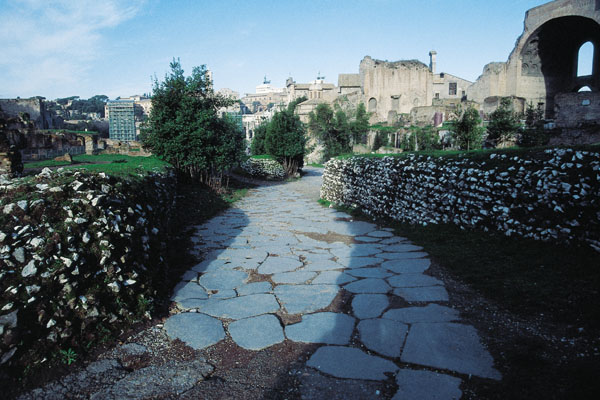
Caesar’s funeral can be related directly to one of the Forum’s buildings, the Temple of the Deified Julius Caesar, at the east end of the Forum, near the site of Caesar’s funeral pyre. It was built in 29 B.C. by Caesar’s successor, Augustus, who was Caesar’s nephew and adopted son. Facing directly onto the main space of the Forum, the temple not only reminded the plebeians of Caesar’s popularity, but also linked the reigning Augustus to the dead Caesar. It certainly did Augustus no harm to remind people that his uncle and adoptive father was a god.
Instead of the usual staircase in front leading up to the porch, this temple had a tall speaker’s platform, or rostra, whose tufa core is the most conspicuous remnant of the building today. This rostra was particularly important from a propagandistic point of view, because it faced the main public speaker’s platform of the Forum, the Rostra, at the west end of the Forum. The Rostra has been reconstructed, so the relationship is easy to see.
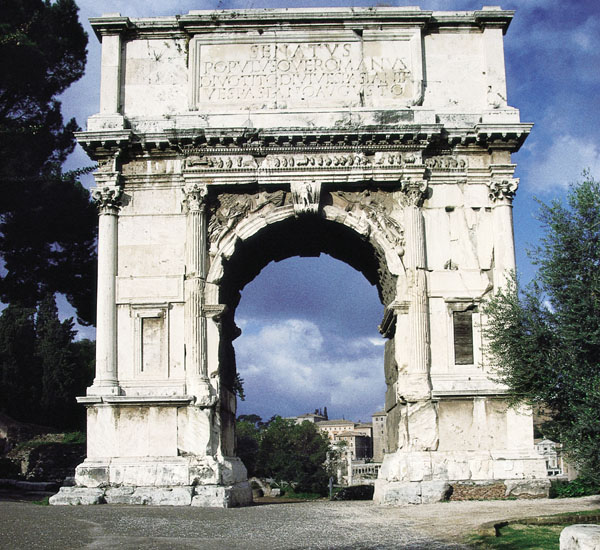
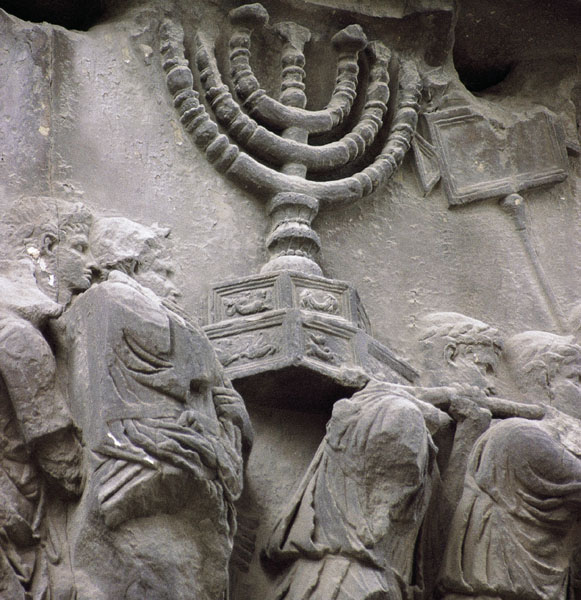
The association was intentional. The Rostra not only served as a speaker’s platform; it was also a symbol of the glory and success of Rome. The word “rostra” is Latin for “beaks,” used here because the platform was decorated by the beaks, or rams, taken from the bows of enemy ships destroyed at the battle of Antium in 338 B.C. (“rostra” is therefore plural because the platform was decorated by several beaks; the commonly used singular “rostrum” is actually incorrect). With the victory at Antium, the Romans dominated the neighboring Sabines and gained control of central Italy—the speaker’s platform decorated as a monument to their victory held deep patriotic meaning for the Romans.
Augustus wanted the Temple of the Deified Caesar to tap into this patriotism, so the rostra in front of Caesar’s temple was built of the “beaks” of ships vanquished in the decisive naval battle of Actium in 31 B.C., in which Augustus defeated Marc Antony and Cleopatra, thus ending a civil war that had lasted a century. In constructing the rostra in front of Caesar’s temple out of the beaks of vanquished ships from the battle of Actium, Augustus was effectively saying that his victory at Actium was equivalent to the earlier victory at Antium.
Alas, the sparkling marble revetment that covered Caesar’s temple, the ship’s beaks attached to it, and the fine Corinthian porch colonnade are long gone. Now all we see is a rather drab pile of dark tufa.
Caesar’s temple was not the only one in the Forum, however. Nearly all of the columns still standing today belonged to temples, including temples to Saturn, Castor and Pollux, and Concord. Deified emperors for whom temples were built in the Forum of Rome include Vespasian (60–79 A.D.) and Antoninus Pius (138–161 A.D.). In addition, a number of commemorative columns and statues (none of the latter are left) honored various Roman heroes, both legendary and historical. The column of Phocas still stands. Dating to 608 A.D., it honors the Byzantine emperor Phocas, and is one of the last ancient monuments set up in the Forum. Diocletian also erected a columnar monument, to commemorate his decennalia (tenth year in office) in 303 A.D. The column no longer stands, but the fine reliefs that decorated its base remain near the Arch of Septimius Severus.
A separate sanctuary with a temple was reserved for Vesta, the goddess of the hearth—in this case the hearth for all of Rome, as if Rome were one great family. The sanctuary included the Atrium Vestae, the home of the vestal virgins, who maintained the eternal fire in Vesta’s hearth.
The equivalent of the modern courthouse was the basilica. Actually, there are three major basilicas in the Roman forum: the Basilica Julia, the Basilica Aemilia and the grand Basilica of Maxentius and Constantine, built in the fourth century A.D. Other government functions were housed in buildings near the basilicas. The curia was the meeting hall of the senate. The Temple of Saturn housed the city treasury. The Tabularium kept the official records.
Shops opened onto the forum from the south side of the Basilica Aemilia. The Basilica Aemilia was destroyed by a fire in 401 A.D. Some of the money changers apparently didn’t get out in time, or perhaps they got out so quickly that they left their money behind. In any event, when the building was excavated, some of their bronze coins were found melted and fused to the floor, where they remain to this day.
A huge triumphal arch anchors each end of the Forum. Triumphal arches commemorated the military achievements of particular emperors; they are true monuments to real historical events. The word “triumphal,” however, does not refer to the victory itself. Rather, a triumph was an honor granted to the victorious general by vote of the senate. The honor was bestowed in the form of a great public celebration, including a raucous parade that progressed along a traditional route called the Via Sacra, or Sacred Way. The Sacred Way wound through the city, approaching the Forum from the east. The Sacred Way was the obvious place to erect an arch to commemorate a triumph, and two arches mark the path of the Sacred Way through the Roman Forum: the Arch of Titus at the east end and the Arch of Septimius Severus in the northwest corner.
Ordinarily, for the sake of civil order, soldiers were not allowed to carry their weapons into the city of Rome; the triumph was the single exception. The victorious general was allowed to lead his army, fully armed, along the Sacred Way, carrying war booty, prisoners, signs, paintings and floats explaining the events of the victory. The most famous triumph honored Julius Caesar for conquering Gaul (France) and adding it to the empire. One of the explanatory placards in the triumph read Veni Vidi Vici, “I came; I saw; I conquered.” The general himself rode in a chariot preceded by an enormous entourage, suitable for his exalted status. He was accompanied in the chariot by a slave holding the laurel victory wreath over his head. But the slave also constantly reminded the emperor that he shouldn’t let his fame go to his head: Be proud, just not too proud.
At the northwest corner of the Forum, the Sacred Way winds its way up to the top of the Capitoline Hill on a paved ramp that can still be seen. At the end of the Sacred Way was the greatest temple in Rome, the Capitolium, dedicated to the three patron deities of the city, Jupiter, Juno and Minerva. The Capitolium no longer stands, but originally the six huge columns of its front porch towered over the west end of the Forum, providing an obvious focal point for the whole Forum and a destination for the Via Sacra.
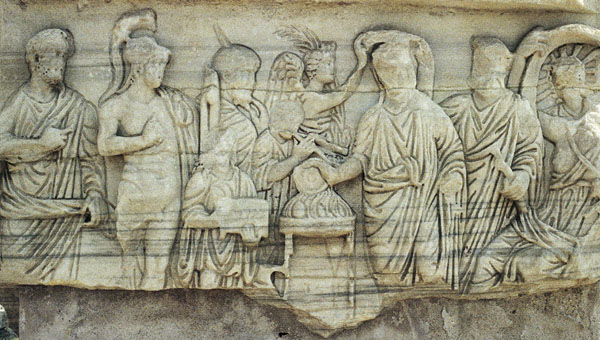
When the triumphal procession reached the Temple of the Capitoline Triad, the spoils of war were offered to Jupiter. Bulls were sacrificed and the whole city joined in a victory feast.
At the east end of the Forum, the splendid Arch of Titus commemorates Titus’s conquest of Jerusalem (70 A.D.) and suppression of the First Jewish Revolt. The arch was erected in 81 A.D. (after Titus’s death in that year) by his brother and successor Domitian, to remind Rome of his glorious family. The “soul” of Titus, duly deified, can be seen on the under surface of the arch, at the very top, riding to heaven on the back of Jupiter’s eagle.
The capitals on the Arch of Titus are the first known instance of the composite order, a combination of the acanthus leaf motif of the Corinthian order topped by the volute motif of the Ionic order.
The frieze (the narrow horizontal band above the columns) has reliefs showing the triumphal procession, with sacrificial bulls being led to altars near the Capitolium. Winged Nike (victory) figures flank the outer curved edges of the arch.
The actual triumphal procession is shown in two relief panels facing each other inside the arch on the inner surfaces of the piers. The south panel shows Titus’s soldiers carrying war booty, the Menorah (the seven-armed lamp stand) and the offering table (shewbread table) from the Jerusalem Temple. The troops can be seen about to pass through an arch, usually thought to mean that they are entering the Porta Triumphalis, an arch that symbolized entering the city during a triumph.
The north panel is more symbolic. It shows Titus’s chariot pulled by four magnificent horses and preceded by some of the imperial entourage. In the chariot stands Titus, unfortunately with his face badly damaged. Above his head is not the traditional slave holding laurels, but rather an allegorical figure of victory, the winged Nike. In such a grand public victory monument, this bit of artistic license makes reasonable sense. Next to the chariot are two men, one older, bearded and fully clothed; the other younger and nude to the waist. These are allegorical figures for the senate and people of Rome respectively. The Latin for “senate and people of Rome” is Senatus Populusque Romanus, commonly abbreviated as the famous “SPQR,” still used as a symbol for the city of Rome. The two allegorical figures tell us that the entire city turned out to cheer Titus as he celebrated his triumph.
The Jewish historian Flavius Josephus, who led a contingent of Jewish troops in the war and then defected to the Romans, wrote a detailed history of the Jewish Revolt. The hard-fought revolt was desperate and bloody, especially in Jerusalem, and Josephus’s vivid account gives a good sense of just how substantial an achievement the Roman victory was. After the revolt was suppressed, Josephus tells us, 700 of the biggest and most powerful Jewish soldiers were sent to Rome to be displayed in the triumph. Josephus also describes the booty: “Most of the spoils that were carried were heaped up indiscriminately, but more prominent than all the rest were those captured in the Temple at Jerusalem—a golden table weighing several hundredweight, and a lampstand similarly made of gold” (The Jewish War 7.5.3). Both are illustrated in a relief under the arch.
The triumph was clearly a major social event. In Josephus’s words: “Not one person stayed home out of the immense population of the city. Everyone came out and, although there was only standing-room, found a place somewhere, so that there was barely enough room left for the procession to pass” (Jewish War 7.5.3).
By 203 A.D., when Septimius Severus added his arch in the northwest corner of the Forum, emperors had been erecting triumphal arches for over two centuries. Each new arch had to be at least as big and as grand as its predecessors, or it would look weak and inconsequential in comparison. The change is obvious when comparing the arches of Titus and Septimius. The motifs are essentially the same, but anything on the Arch of Titus appears bigger, grander and usually in greater numbers on the Arch of Septimius. Thus the Arch of Septimius has three arched passageways, instead of one, free-standing composite columns on projecting podia, complex decorative moldings anywhere they could be applied and dozens of relief panels commemorating the numerous military achievements of Septimius during the first ten years of his reign. Even the inscription was increased; indeed, it was so long-winded that probably very few people bothered to read it all. From Septimius’s point of view, his arch simply had to be conspicuously bigger, grander and fancier than any that had come before.
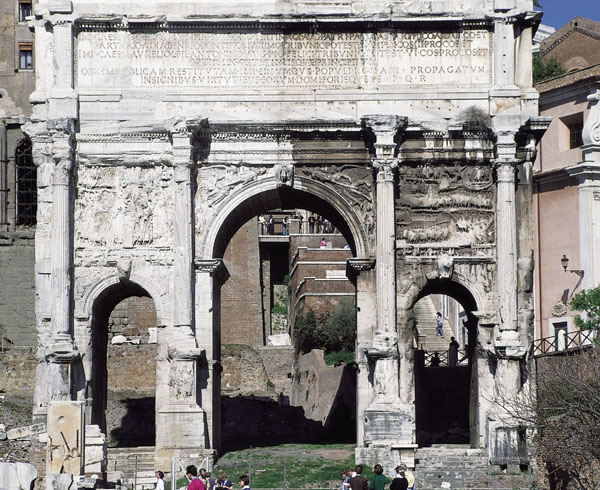
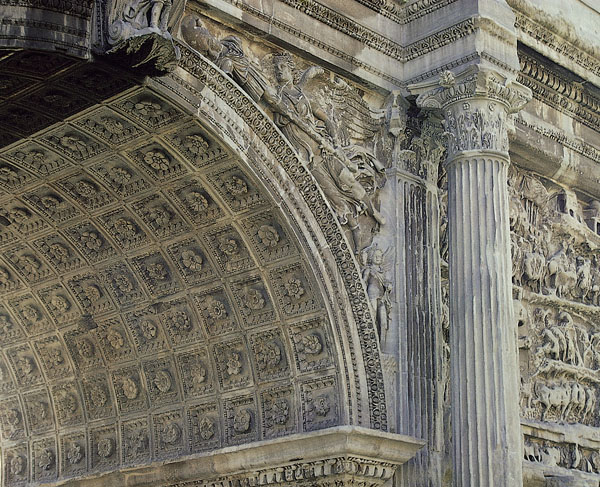
The Roman Forum was much more than buildings and space. It had a human component, equally as important as the architecture. Indeed, without the human component, the Roman Forum would be meaningless. A place is not inherently important unless someone values it. If many people value it, it is more important, and if great masses value it highly over the course of a millennium, its significance becomes overwhelming. The Roman Forum is that kind of place, and its buildings were suitably grand. In looking at the remains of the Roman Forum today, we must also remember the people behind the buildings, in order to bring their culture back to life. We can still sense the pride, accomplishment and authority that the Romans wanted their Forum to express.







